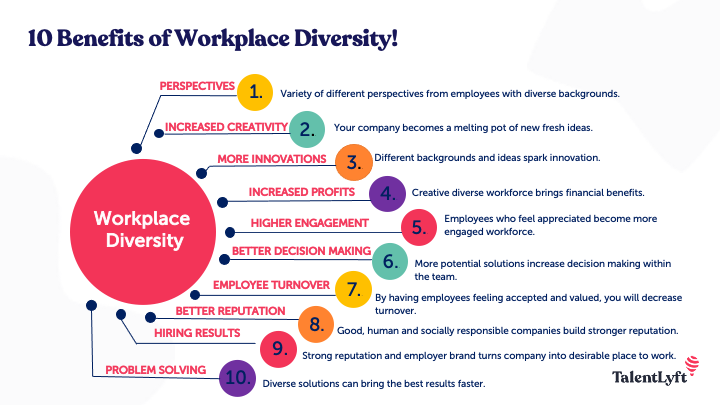Imagine a workplace where every voice is heard, every culture celebrated, and every perspective valued. This is not just an ideal scenario; it’s achievable through effective diversity management.
As you navigate your career, you might wonder how diversity impacts your work life and the overall success of your organization. Understanding diversity management in the workplace is crucial for fostering an inclusive environment that boosts creativity, innovation, and productivity.
Have you ever felt that your unique background or ideas were overlooked? You’re not alone. Many employees face similar challenges, and tackling them can transform your work experience. As you read on, you’ll discover practical strategies to enhance diversity management, helping you create a work atmosphere where everyone can thrive. Uncover the benefits of embracing diversity and learn how it can propel your career and your organization to new heights. Don’t miss out on this opportunity to make a meaningful difference in your workplace.
Table of Contents
ToggleImportance of Diversity Management
Embracing diversity management fosters a harmonious workplace. It enhances creativity and innovation by bringing varied perspectives together. Employees feel valued and respected, boosting morale and productivity.
In today’s globalized world, understanding and appreciating diversity in the workplace is crucial. You might ask, why is diversity management so important? It’s simple—embracing diversity leads to innovation, creativity, and a more harmonious work environment. It’s not just about ticking a box, but about nurturing an inclusive atmosphere where everyone feels valued.
Enhancing Creativity and Innovation
When diverse minds come together, magic happens. Imagine a brainstorming session with people from different backgrounds and experiences. The ideas generated are not only creative but offer unique solutions. Diversity management ensures that these diverse perspectives are not just heard but valued. This leads to breakthrough innovations that might never occur in a homogenous group. How can your workplace harness this potential? ###
Improving Employee Engagement
Feeling valued and understood is a fundamental human need. Diversity management fosters an environment where employees feel their unique perspectives matter. When you feel appreciated, your engagement and productivity skyrocket. You become more invested in your work and the success of your team. How engaged do you feel in your current role?
Boosting Reputation and Growth
Companies known for their inclusive practices attract top talent. If potential employees see that diversity is prioritized, they are more likely to want to join your team. This reputation isn’t just good for hiring; it’s great for business growth. Customers notice and prefer companies that reflect their values. Can your company afford not to prioritize diversity?
Reducing Conflict and Promoting Collaboration
With diversity management, you can reduce workplace conflicts. When everyone understands and respects each other’s differences, collaboration becomes easier. This environment fosters mutual respect and reduces misunderstandings. Have you experienced conflict due to a lack of understanding in your workplace? ###
Enhancing Problem-solving Skills
Diverse teams have a broader range of experiences to draw upon. This diversity in thought leads to more effective problem-solving. Different perspectives mean more avenues explored and innovative solutions found. What problems could your team solve with a diversity of thought?
Practical Steps to Implement Diversity Management
Implementing diversity management starts with acknowledging its importance. Begin by assessing your current workplace environment. Encourage open discussions about diversity and inclusion. Provide training to help your team understand and value differences. Small steps can lead to significant changes. What practical steps can you take today to foster diversity in your workplace? As you consider these aspects of diversity management, think about your own experiences. Reflect on times when diversity enriched your work environment. How can you contribute to creating a more inclusive workplace?
Benefits of a Diverse Workforce
A diverse workforce brings fresh ideas and perspectives, enhancing creativity and innovation. It helps companies understand different markets better, leading to improved customer satisfaction. Diversity management in the workplace can also boost employee morale and productivity, creating a more inclusive environment for everyone.
In today’s rapidly evolving business landscape, understanding the benefits of a diverse workforce is essential for any organization aiming to thrive. Diversity management isn’t just a buzzword; it’s a strategic advantage that drives productivity and innovation. Embracing varied perspectives creates a dynamic environment where creativity flourishes, problems are solved more effectively, and market opportunities expand. Let’s delve into these benefits more deeply.
Enhanced Creativity and Innovation
A workplace rich in diversity sparks creativity. When people from different backgrounds collaborate, they bring unique ideas to the table. Imagine the brainstorming sessions where diverse teams challenge the norm and propose out-of-the-box solutions. You might notice more innovative products and services emerging from these discussions. A simple conversation with a colleague from a different cultural background can inspire a groundbreaking idea. Have you ever considered how your personal experiences could shape your creative thinking?
Improved Problem Solving
Diverse teams excel at problem solving because they consider multiple angles. When faced with a challenge, individuals from varied backgrounds offer alternative viewpoints and strategies. This broad perspective can lead to more effective solutions that might not be evident in a homogenous group. Think about a time when a coworker’s different approach helped you see a problem in a new light. It’s not just about finding answers; it’s about discovering better methods. Are you leveraging the diverse talents in your team to tackle complex issues?
Increased Market Reach
A diverse workforce offers insights into different customer segments, helping you tap into new markets. Employees who understand cultural nuances can tailor products and marketing strategies to resonate with a broader audience. Consider how a multilingual team member can connect with international clients, opening doors to global business opportunities. Reflect on how diversity within your organization can expand your market reach. Are you ready to embrace these opportunities? Incorporating diversity into your workforce is more than a moral imperative; it’s a business strategy that can propel your organization to new heights. By nurturing creativity, enhancing problem-solving capabilities, and increasing market reach, you pave the way for sustained growth and success.
Challenges in Implementing Diversity
Implementing diversity in the workplace can bring many benefits. Yet, it also presents significant challenges. These hurdles can slow down progress. Understanding them is key to overcoming them. Let’s explore some common challenges faced by organizations.
Resistance to Change
Change is often met with resistance. Employees may fear losing their jobs. Others might feel uncomfortable with new policies. Leaders must communicate the benefits clearly. They should engage employees in the process. This can ease fears and build trust.
Unconscious Bias
Unconscious bias can be hard to detect. It affects decisions without awareness. Bias can lead to unfair treatment. Training programs can help identify biases. They teach employees to recognize and reduce them. This fosters a fair workplace.
Cultural Misunderstandings
Cultural differences can lead to misunderstandings. Language barriers might cause confusion. Different customs can create tension. Organizations should promote cultural awareness. Workshops and open discussions are useful. They help bridge gaps and enhance teamwork.

Credit: www.superbeings.ai
Strategies for Effective Diversity Management
Diversity management in the workplace isn’t just a buzzword; it’s a necessary strategy for fostering a healthy, productive, and innovative work environment. Effective diversity management strategies can help you harness the unique strengths of a diverse workforce, creating a competitive advantage. How can you implement these strategies to ensure every voice is heard and valued?
Inclusive Recruitment Practices
Start by reevaluating your recruitment process. Are you reaching a wide range of candidates? Expand your job postings to platforms that cater to diverse communities. Craft job descriptions that emphasize your commitment to diversity and inclusion.
Consider blind recruitment practices to focus on skills and experience rather than names or backgrounds. This can help reduce unconscious bias and ensure a fair selection process. Remember, diversity starts at the hiring level.
Diversity Training Programs
Equip your team with the knowledge they need through diversity training programs. These sessions should go beyond superficial awareness. Focus on understanding different perspectives and how they contribute to your team’s success.
Encourage active participation by creating interactive workshops rather than passive presentations. Share stories and scenarios that reflect real-life challenges and solutions. Training should be a continuous effort, not a one-time event.
Creating an Inclusive Culture
Building an inclusive culture goes beyond policies. It’s about fostering an environment where everyone feels they belong. Encourage open dialogue and ensure all voices are heard during meetings. Ask yourself: Are you creating spaces where people feel comfortable sharing their ideas?
Celebrate diverse holidays and cultural events within the workplace. This not only educates but also shows appreciation for different cultures. Encourage team members to share their stories and experiences, making diversity a lived experience rather than a checklist.
Diversity management is a journey, not a destination. By taking actionable steps, you can create a workplace that thrives on the strengths of its diverse members. What strategies will you apply today to make a meaningful impact?
Role of Leadership in Diversity
Leadership plays a vital role in fostering diversity in the workplace. Leaders set examples that influence company culture. Their actions and policies can create an inclusive environment. A workplace where everyone feels valued and respected. Let’s explore how leadership impacts diversity through key actions.
Setting the Tone from the Top
Leaders must demonstrate commitment to diversity. Their behavior sets the standard for others. By valuing diverse perspectives, leaders encourage a similar mindset across the organization. They must actively promote equality. This includes hiring practices and decision-making processes.
Promoting Open Communication
Open communication is crucial for embracing diversity. Leaders should create safe spaces for dialogue. Employees must feel comfortable sharing thoughts and experiences. This openness builds trust and understanding. It also fosters collaboration among diverse teams.
Supporting Diversity Initiatives
Leaders must support diversity programs actively. Participation in workshops and training is essential. They should allocate resources for diversity initiatives. Recognizing and rewarding efforts in this area is important. Such support shows genuine commitment to diversity goals.
Measuring Diversity Success
Measuring diversity success is crucial for workplace growth. Organizations need effective strategies to assess their diversity initiatives. This involves setting clear goals, conducting regular audits, and encouraging feedback for continuous improvement. These elements help in understanding how diversity influences productivity and employee satisfaction.
Setting Clear Goals
Define specific diversity objectives. Consider what diversity means for your organization. Goals should be measurable and achievable. For example, aim to increase minority representation by a certain percentage. Clear goals guide actions and focus efforts.
Regular Diversity Audits
Conduct audits frequently. They assess current diversity levels and identify gaps. Use data to understand demographic trends. Analyze recruitment, retention, and promotions. Audits help track progress and pinpoint areas needing attention.
Feedback and Continuous Improvement
Encourage open dialogue among employees. Gather feedback through surveys or meetings. Understand their experiences and challenges. Use insights to refine diversity strategies. Continuous improvement fosters a supportive, inclusive environment.
Case Studies of Successful Diversity Management
Successful diversity management improves workplace culture and productivity. Case studies show how diverse teams solve problems better. Companies see growth by embracing different perspectives and ideas.
Diversity management in the workplace is more than just a buzzword; it’s a powerful strategy that can transform the dynamics of any organization. By fostering a diverse environment, companies can benefit from varied perspectives, which can drive innovation and enhance productivity. So, how do successful organizations implement diversity management effectively? Let’s delve into some compelling case studies that highlight practical approaches and outcomes.
Case Study: Google’s Inclusive Culture
Google has been at the forefront of diversity management. Their approach includes comprehensive training programs for all employees. They focus on unconscious bias and promote a culture of respect and inclusion. Have you ever wondered how such initiatives can change the workplace environment? By educating employees about biases, Google encourages open dialogue and fosters a supportive community. This makes employees feel valued and understood, leading to higher job satisfaction and retention rates.
Case Study: Starbucks’ Community Building
Starbucks is another shining example. They have implemented community-building initiatives to promote diversity. This includes hosting open forums and discussions on social issues, allowing employees to express their thoughts freely. You might ask, why is community building effective? It helps employees connect on a personal level, breaking down barriers and creating a sense of belonging. The result? A harmonious workplace where everyone feels part of a larger mission.
Case Study: Ibm’s Diverse Leadership
IBM has taken diversity management to the leadership level. They actively recruit diverse leaders and encourage mentorship programs. This ensures varied perspectives at the decision-making table. Imagine the possibilities when diverse voices lead the charge. IBM’s approach not only enhances innovation but also sets a precedent for others in the industry. It’s a reminder that diversity starts from the top and trickles down, influencing every layer of the organization.
Case Study: Accenture’s Employee Resource Groups
Accenture has established Employee Resource Groups (ERGs) that empower employees to connect over shared identities and interests. These groups provide support and advocate for inclusive policies. Have you considered the impact of such groups? They offer a safe space for employees, fostering networking and professional growth. Accenture’s ERGs have been pivotal in creating a workplace where diversity is celebrated and leveraged for success. Reflecting on these cases, how can you implement similar strategies in your organization? By embracing diversity and actively managing it, you can create a thriving work environment that benefits everyone involved.

Credit: www.talentlyft.com

Credit: www.thehumancapitalhub.com
Frequently Asked Questions
What Is Diversity Management in The Workplace?
Diversity management involves creating a workplace that values different backgrounds. It promotes inclusion, equality, and respect. Implementing effective policies can improve employee satisfaction and productivity. Businesses benefit from diverse perspectives, enhancing creativity and innovation. Effective diversity management fosters a supportive work environment for all individuals.
What Are the 4 Types of Diversity in the Workplace?
The four types of workplace diversity are demographic, experiential, cognitive, and behavioral. Demographic diversity includes race and gender. Experiential diversity covers life experiences. Cognitive diversity involves different thinking styles. Behavioral diversity focuses on varying work habits and social interactions.
How Do You Effectively Manage Diversity in the Workplace?
Embrace open communication to understand diverse perspectives. Implement inclusive policies and provide diversity training. Encourage collaboration and respect among employees. Promote a culture of equality and celebrate diverse achievements. Regularly assess and adapt strategies to ensure ongoing inclusivity.
What Are the Three C’s of Managing Diversity?
The three C’s of managing diversity are commitment, communication, and competence. Commitment involves dedication to diversity goals. Communication ensures open dialogue. Competence requires skills to manage diverse teams effectively.
Conclusion
Embracing diversity in the workplace fosters growth and innovation. Different perspectives lead to better problem-solving and creativity. Every employee feels valued and respected. This boosts morale and productivity. Diversity management requires effort, but the rewards are significant. Companies build stronger, more inclusive teams.
They attract top talent and improve retention. Customers notice and appreciate diverse businesses. It’s not just about meeting quotas. It’s about creating an environment where everyone thrives. Start today. Encourage inclusion and celebrate differences. Your business will benefit. Your team will flourish.




